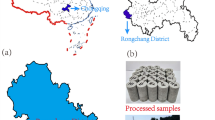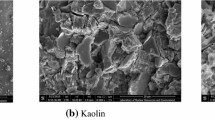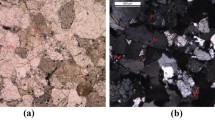Abstract
Understanding the variations of the physical-mechanical properties of the surrounding rock in coupled thermal and acidic groundwater erosion environment, from the perspective of its micro-structure, is crucial for ensuring the safety and long-term sustainability of rock engineering (e.g., tunnels, slopes, shafts). In this study, the relationship between the mechanical behavior and microstructure evolutions of red sandstone from the southern part of Jiangxi Province, China, under thermal and chemical erosion treatments is experimentally investigated. The results show that the micro-structure of red sandstone is dominated by micropores, accounting for about 60% when the heating temperature is lower than 700 °C. 700-800 °C is the temperature range in which the internal pore structure of red sandstone is remarkably changed, and the proportion of macropores, mesopores, and cracks grows gradually, whereas the proportion of micropores shows a declining trend. Both tensile strength and P-wave velocity show a significant decrease subjected to high temperatures beyond 700 °C and acid solution erosion. The internal microstructure of red sandstone shows a large number of trans-granular cracks due to thermal stress and mineral reaction, while the erosion by acid solution causes a large increase of secondary pores. In addition, the micro-structural changes were further elaborated by the variations of mineral element (Si and O) content tested by the Energy Dispersive Spectrometer (EDS). To sum up, the fundamental mechanism governing the degradation of macroscopic physical properties and tensile strength involves mineral phase transitions and ion exchanges induced by the combined effects of temperature and acid solution erosion, leading to the damage of the microstructure and the development of cracks.













Similar content being viewed by others
Data availability
Data will be made available on request.
References
Cai YD, Liu DM, Pan ZJ, Yao YB, Li JQ, Qiu YK (2013) Petrophysical characterization of Chinese coal cores with heat treatment by nuclear magnetic resonance. Fuel 108:292–302. https://doi.org/10.1016/j.fuel.2013.02.031
Cai YY, Yu J, Fu GF, Li H (2016) Experimental investigation on the relevance of mechanical properties and porosity of sandstone after hydrochemical erosion. J Mt Sci 13(11):2053–2068. https://doi.org/10.1007/s11629-016-4007-2
Deng LC, Li XZ, Wu Y, Li FQ, Huang Z, Ji YK, Zou CJ, Liu ZX (2022) Influence of cooling speed on the physical and mechanical properties of granite in geothermal-related engineering. Deep Undergr Sci. Eng. 1(1):40–57. https://doi.org/10.1002/dug2.12011
Diederichs U, Jumppanen UM, Schneider U (1995) High temperature properties and spalling behaviour of high strength concrete. In: Proceedings of Fourth Weimar Workshop on High Performance Concrete, HAB Weimar, Germany, pp. 219-235
Fang XY, Xu JY, Wang PX (2018) Compressive failure characteristics of yellow sandstone subjected to the coupling effects of chemical corrosion and repeated freezing and thawing. Eng Geol 233:160–171. https://doi.org/10.1016/j.enggeo.2017.12.014
Feng YJ, Su HJ, Yin Q, Yu LY, Wang YC (2021) Experimental Study on Mechanical Property and Pore Distribution of Limestone Specimens after Heat Treatment under Different Heating Conditions. Adv Mater Sci Eng 2021. https://doi.org/10.1155/2021/9957330
Gu Q, Huang Z, Li SJ, Zeng W, Wu Y, Zhao K (2020) An approach for water-inrush risk assessment of deep coal seam mining: a case study in Xinlongzhuang coal mine. Environ Sci Pollut R 27(34):43163–43176. https://doi.org/10.1007/s11356-020-10225-0
Han TL, Shi JP, Chen YS, Li ZH (2016) Effect of chemical corrosion on the mechanical characteristics of parent rocks for nuclear waste storage. Sci Technol Nucl Ins 2016. https://doi.org/10.1155/2016/7853787
Huang D, Cen D, Song Y (2020) Comparative investigation on the compression-shear and tension-shear behaviour of sandstone at different shearing rates. Rock Mech Rock Eng 53:3111–3131. https://doi.org/10.1007/s00603-020-02094-3
Huang X, Pang JY, Liu GC, Chen Y (2020b) Experimental study on physico-mechanical properties of deep sandstone by coupling of dry-wet cycles and acidic environment. Adv Civ Eng 2020. https://doi.org/10.1155/2020/2760952
Huang Z, Zeng W, Zhao K (2019) Experimental investigation of the variations in hydraulic properties of a fault zone in Western Shandong, China. J Hydrol 574:822–835. https://doi.org/10.1016/j.jhydrol.2019.04.063
Huang Z, Zeng W, Gu QX, Wu Y, Zhong W, Zhao K (2021) Investigations of variations in physical and mechanical properties of granite, sandstone, and marble after temperature and acid solution treatments. Construct Build Mater 307:124943. https://doi.org/10.1016/j.conbuildmat.2021.124943
Huang Z, Zhao K, Li XZ, Zhong W, Wu Y (2021) Numerical characterization of groundwater flow and fracture-induced water inrush in tunnels. Tunn Undergr Space Technol 116:104119. https://doi.org/10.1016/j.tust.2021.104119
Huang Z, Zeng W, Wu Y, Li SJ, Gu QX, Zhao K (2021) Effects of temperature and acid solution on the physical and tensile mechanical properties of red sandstones. Environ Sci Pollut R 28(16):20608–20623. https://doi.org/10.1007/s11356-020-11866-x
Jing XD, Sun Q, Jia HL, Ge ZL, Wang T (2021) Influence of high-temperature thermal cycles on the pore structure of red sandstone. B Eng Geol Environ 80(10):7817–7830. https://doi.org/10.1007/s10064-021-02389-x
Kachanov LM (1999) Rupture time under creep conditions. Int J Fracture 97(1):11–18. https://doi.org/10.1023/A:1018671022008
Krajcinovic D (1989) Damage mechanics. Mech Mater 8(2–3):117–197
Lai JX, Zhou H, Cheng F, Wang K, Feng ZH (2017) Statistical Analysis of Fire Accidents in Highway Tunnels and Countermeasures for Disaster Prevention and Reduction. Tunn Construct 04:409–415 (in Chinese)
Li H, Zhong ZL, Liu XR, Sheng Y, Yang DM (2018) Micro-damage evolution and macro-mechanical property degradation of limestone due to chemical effects. Int J Rock Mech Min Sci 110:257–265. https://doi.org/10.1016/j.ijrmms.2018.07.011
Li JL, Kaunda RB, Zhou KP (2018) Experimental investigations on the effects of ambient freeze-thaw cycling on dynamic properties and rock pore structure deterioration of sandstone. Cold Reg Sci Technol 154:133–141. https://doi.org/10.1016/j.coldregions.2018.06.015
Li JL, Kaunda RB, Zhu LY, Zhou KP, Gao F (2019a) Experimental study of the pore structure deterioration of sandstones under freeze-thaw cycles and chemical erosion. Adv Civ Eng 2019. https://doi.org/10.1155/2019/9687843
Li M, Wang DM, Shao ZL (2020) Experimental study on changes of pore structure and mechanical properties of sandstone after high-temperature treatment using nuclear magnetic resonance. Eng Geol 275:105739. https://doi.org/10.1016/j.enggeo.2020.105739
Li SG, Huo RK, Yoshiaki F, Ren DZ, Song ZP (2019) Effect of acid-temperature-pressure on the damage characteristics of sandstone. Int J Rock Mech Min Sci 122:104079. https://doi.org/10.1016/j.ijrmms.2019.104079
Lin Y, Zhou KP, Li JL, Ke B, Gao RG (2020) Weakening laws of mechanical properties of sandstone under the effect of chemical corrosion. Rock Mech Rock Eng 53(4):1857–1877. https://doi.org/10.1007/s00603-019-01998-z
Liu QS, Qian ZC, Wu ZJ (2019) Micro/macro physical and mechanical variation of red sandstone subjected to cyclic heating and cooling: an experimental study. B Eng Geol Environ 78(3):1485–1499. https://doi.org/10.1007/s10064-017-1196-z
Liu S, Xu J (2014) Mechanical properties of Qinling biotite granite after high temperature treatment. Int J Rock Mech Min Sci 71:188–193
Mahanta B, Vishal V, Ranjith PG, Singh TN (2020) An insight into pore-network models of high-temperature heat-treated sandstones using computed tomography. J Nat Gas Sci Eng 77:103227. https://doi.org/10.1016/j.jngse.2020.103227
Mashimo H (2002) State of the road tunnel safety technology in Japan. Tunn Undergr Space Technol 17(2):145–152. https://doi.org/10.1016/S0886-7798(02)00017-2
Nasseri MHB, Schubnel A, Young RP (2007) Coupled evolutions of fracture toughness and elastic wave velocities at high crack density in thermally treated Westerly granite. Int J Rock Mech Min Sci 44(4):601–616. https://doi.org/10.1007/s11069-021-04647-3
Nævestad TO, Meyer S (2014) A survey of vehicle fires in Norwegian road tunnels 2008–2011. Tunn Undergr Space Technol 41:104–112. https://doi.org/10.1016/j.tust.2013.12.001
Rabotnov YN (1969) Creep rupture. In Applied Mechanics (pp. 342-349). Springer, Berlin, Heidelberg.
Ranjith PG, Viete DR, Chen BJ, Perera MSA (2012) Transformation plasticity and the effect of temperature on the mechanical behaviour of Hawkesbury sandstone at atmospheric pressure. Eng Geol 151:120–127. https://doi.org/10.1016/j.enggeo.2012.09.007
Rao QH, Wang Z, Xie HF, Xie Q (2007) Experimental study of mechanical properties of sandstone at high temperature. J Cent South Univ Technol 14(1):478–483. https://doi.org/10.1007/s11771-007-0311-x
Ren R, Zhou H, Hu Z, He SY, Wang XL (2019) Statistical analysis of fire accidents in Chinese highway tunnels 2000–2016. Tunn Undergr Space Technol 83:452–460. https://doi.org/10.1016/j.tust.2018.10.008
Santos-Reyes J, Beard AN (2017) An analysis of the emergency response system of the 1996 Channel tunnel fire. Tunn Undergr Space Technol 65:121–139. https://doi.org/10.1016/j.tust.2017.02.011
Sha S, Rong G, Peng J, Li B, Wu ZJ (2019) Effect of open-fire-induced damage on Brazilian tensile strength and microstructure of granite. Rock Mech Rock Eng 52:4189–4202. https://doi.org/10.1007/s00603-019-01871-z
Sha S, Rong G, Chen Z, Li B, Zhang Z (2020) Experimental evaluation of physical and mechanical properties of geothermal reservoir rock after different cooling treatments. Rock Mech Rock Eng 53:4967–4991. https://doi.org/10.1007/s00603-020-02200-5
Sun H, Sun Q, Deng WN, Zhang WQ, Lü C (2017) Temperature effect on microstructure and P-wave propagation in Linyi sandstone. Appl Therm Eng 115:913–922. https://doi.org/10.1016/j.applthermaleng.2017.01.026
Sun Q, Zhang WQ, Su TM, Zhu SY (2016) Variation of wave velocity and porosity of sandstone after high temperature heating. Acta Geophys 64(3):633–648. https://doi.org/10.1515/acgeo-2016-0021
Tang ZC, Sun M, Peng J (2019) Influence of high temperature duration on physical, thermal and mechanical properties of a fine-grained marble. Appl Therm Eng 156:34–50. https://doi.org/10.1016/j.applthermaleng.2019.04.039
Ulusay R, Hudson JA (2007) The complete ISRMsuggested methods for rock characterization, testing and monitoring: 1974-2006. ISRM Commission on Testing Methods, Ankata.
Wasantha PLP, Guerrieri M, Xu T (2021) Effects of tunnel fires on the mechanical behaviour of rocks in the vicinity–A review. Tunn Undergr Space Technol 108:103667. https://doi.org/10.1016/j.tust.2018.10.008
Wei SJ, Yang YS, Su CD, Cardosh SR, Wang H (2019) Experimental study of the effect of high temperature on the mechanical properties of coarse sandstone. Appl Sci 9(12):2424. https://doi.org/10.3390/app9122424
Wu Y, Hu LH, Yu J, Li XZ, Yang LN, Xue S, Zhang K (2023) The sensitivity of mechanical properties and pore structures of Beishan granite to large variation of temperature in nuclear waste storage sites. Environ. Sci. Pollut. R. 1-18. https://doi.org/10.1007/s11356-023-27510-3
Wu Y, Li XZ, Huang Z, Xue S (2021) Effect of temperature on physical and mechanical and acoustic emission properties of Beishan granite, Gansu Province China. Nat Hazards 107(2):1577–1592. https://doi.org/10.1007/s11069-021-04647-3
Yang LT, Marshall AM, Wanatowski D, Stace R, Ekneligoda T (2017) Effect of high temperatures on sandstone–a computed tomography scan study. Int J Phys Model Geo 17(2):75–90. https://doi.org/10.1680/jphmg.15.00031
Zeiml M, Lackner R, Mang HA (2008) Experimental insight into spalling behavior of concrete tunnel linings under fire loading. Acta Geotech 3(4):295–308. https://doi.org/10.1007/s11440-008-0069-9
Zhang J, Deng HW, Taheri A, Ke B, Liu CJ, Yang XR (2018) Degradation of physical and mechanical properties of sandstone subjected to freeze-thaw cycles and chemical erosion. Cold Reg Sci Technol 155:37–46. https://doi.org/10.1016/j.coldregions.2018.07.007
Zhang JY, Shen YJ, Yang GS, Zhang H, Wang YZ, Hou X, Sun Q, Li GY (2021) Inconsistency of changes in uniaxial compressive strength and P-wave velocity of sandstone after temperature treatments. J Rock Mech Geotech Eng 13(1):143–153. https://doi.org/10.1016/j.jrmge.2020.05.008
Zhang YL, Sun Q, He H, Cao LW, Zhang WQ, Wang B (2017) Pore characteristics and mechanical properties of sandstone under the influence of temperature. Appl Therm Eng 113:537–543. https://doi.org/10.1016/j.applthermaleng.2016.11.061
Zhang WQ, Sun Q, Zhu YM, Guo WH (2019) Experimental study on response characteristics of micro–macroscopic performance of red sandstone after high-temperature treatment. J Therm Anal Calorim 136(5):1935–1945. https://doi.org/10.1007/s10973-018-7880-9
Zhao F, Sun Q, Yang D, Zhang WQ (2019) Thermal effects on failure characteristics of granite with pre-existing fissures. Geotechn Res 6(4):302–311. https://doi.org/10.1680/jgere.19.00019
Zhao HB, Yin GZ, Chen LJ (2009) Experimental Study on Effect of Temperature on Sandstone Damage. Chin J Rock Mech Eng 28(S1):2784–2788 (in Chinese)
Zhao Y, Li PF (2018) A Statistical Analysis of China’s Traffic Tunnel Development Data. Engineering 4(1):3–5. https://doi.org/10.1016/j.eng.2017.12.011
Zhao ZH, Liu ZN, Pu H, Li X (2018) Effect of thermal treatment on Brazilian tensile strength of granites with different grain size distributions. Rock Mech Rock Eng 51(4):1293–1303. https://doi.org/10.1007/s00603-018-1404-6
Zheng CM, Zheng JY, Peng XJ, Zhou L (2022) Influence of chemical corrosion on dynamic fracturing mechanical behavior of marbles. Adv Civ Eng 2022. https://doi.org/10.1155/2022/8182504
Zhu SY, Zhang WQ, Sun Q, Deng S, Geng JS, Li CM (2017) Thermally induced variation of primary wave velocity in granite from Yantai: experimental and modeling results. Int J Therm Sci 114:320–326. https://doi.org/10.1016/j.ijthermalsci.2017.01.008
Acknowledgments
The authors gratefully acknowledge the financial support from the National Natural Science Foundation of China (52274082), the Jiangxi Provincial Natural Science Foundation (20202ACB214006), the Innovative Experts, Long-term Program of Jiangxi Province (jxsq2018106049), the State Key Laboratory of Mining Response and Disaster Prevention and Control in Deep Coal Mines (SKLMRDPC22KF17), the Yunlong Lake Laboratory of Deep Underground Science and Engineering (KC22062, BK20231157), the Program of Qingjiang Excellent Young Talents, Jiangxi University of Science and Technology (JXUSTQJBJ2020003), and the Jiangsu Excellent Postdoctoral Program (2022ZB509).
Author information
Authors and Affiliations
Corresponding author
Ethics declarations
Competing interest
The authors declare that they have no known competing financial interests or personal relationships that could have appeared to influence the work reported in this paper.
Rights and permissions
About this article
Cite this article
Zeng, W., Huang, Z., Li, X. et al. Micro-damage evolution and macro-degradation of red sandstone under thermal and chemical erosion conditions. Bull Eng Geol Environ 83, 74 (2024). https://doi.org/10.1007/s10064-024-03573-5
Received:
Accepted:
Published:
DOI: https://doi.org/10.1007/s10064-024-03573-5




